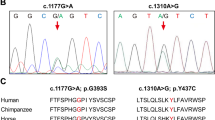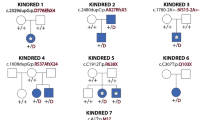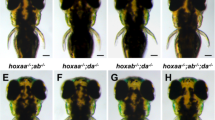Abstract
Rieger syndrome, an autosomal dominant disorder, includes ocular, craniofacial and umbilical abnormalities. The pitx2 homeobox gene, which is mutated in Rieger syndrome1,2, has been proposed to be the effector molecule interpreting left–right axial information from the early embryonic trunk to each organ3,4,5,6,7. Here we have used gene targeting in mice to generate a loss-of-function allele that would be predicted to result in organ randomization or isomerization. Although pitx2-/- embryos had abnormal cardiac morphogenesis, mutant hearts looped in the normal direction. Pitx2-/- embryos had correctly oriented, but arrested, embryonic rotation and right pulmonary isomerism. They also had defective development of the mandibular and maxillary facial prominences, regression of the stomodeum and arrested tooth development. Fgf8 expression was absent, and Bmp4 expression was expanded in the branchial-arch ectoderm. These data reveal a critical role for pitx2 in left–right asymmetry but indicate that pitx2 may function at an intermediate step in cardiac morphogenesis and embryonic rotation.
This is a preview of subscription content, access via your institution
Access options
Subscribe to this journal
Receive 51 print issues and online access
$199.00 per year
only $3.90 per issue
Buy this article
- Purchase on SpringerLink
- Instant access to full article PDF
Prices may be subject to local taxes which are calculated during checkout




Similar content being viewed by others
References
Semina,E. V. et al. Cloning and characterization of a novel bicoid-related homeobox transcription factor gene, RIEG, involved in Rieger syndrome. Nature Genet. 14, 392–399 (1996).
Gage,P. J. & Camper,S. A. Pituitary homeobox 2, a novel member of the bicoid-related family of homeobox genes, is a potential regulator of anterior structure formation. Hum. Mol. Genet. 6, 457–464 (1997).
Logan,M., Pagan-Westphal,S. M., Smith,D. M., Paganessi,L. & Tabin,C. J. The transcription factor Pitx2 mediates situs-specific morphogenesis in response to left-right asymmetric signals. Cell 94, 307–317 (1998).
Piedra,M. E., Icardo,J. M., Albajar,M., Rodriguez-Rey,J. C. & Ros,M. A. Pitx2 participates in the late phase of the pathway controlling left-right asymmetry. Cell 94, 319–324 (1998).
Yoshioka,H. et al. Pitx2, a bicoid-type homeobox gene, is involved in a lefty-signaling pathway in determination of left-right asymmetry. Cell 94, 299–305 (1998).
Ryan,A. K. et al. Pitx2 determines left-right asymmetry of internal organs in vertebrates. Nature 394, 545–551 (1998).
Campione,M. et al. The homeobox gene Pitx2: mediator of asymmetric left-right signaling in vertebrate heart and gut looping. Development 126, 1225–1234 (1999).
Flomen,R. H. et al. Construction and analysis of a sequence-ready map in 4q25: Rieger syndrome can be caused by haploinsufficiency of RIEG, but also by chromosome breaks approximately 90 kb upstream of this gene. Genomics 47, 409–413 (1998).
Harvey,R. P. Links in the left/right axial pathway. Cell 94, 273–276 (1998).
Yost,H. J. Vertebrate left-right development. Cell 82, 689–692 (1995).
Biben,C. & Harvey,R. P. Homeodomain factor Nkx2-5 controls left/right asymmetric expression of bHLH gene eHand during murine heart development. Genes Dev. 11, 1357–1369 (1997).
Kaufman,M. H. The Atlas of Mouse Development (Academic, London, San Diego, New York, 1992).
Mikkila,S. P., Janas,M., Karikoski,R., Tarkkila,T. & Simola,K. O. X-linked laterality sequence in a family with carrier manifestations. Am. J. med. Genet. 49, 435–438 (1994).
Gebbia,M. et al. X-linked situs abnormalities result from mutations in ZIC3. Nature Genet. 17, 305–308 (1997).
Oh,S. P. & Li,E. The signaling pathway mediated by the type IIB activin receptor controls axial patterning and lateral asymmetry in the mouse. Genes Dev. 11, 1812–1826 (1997).
Neubuser,A., Peters,H., Balling,R. & Martin,G. R. Antagonistic interactions between FGF and BMP signaling pathways: a mechanism for positioning the sites of tooth formation. Cell 90, 247–255 (1997).
Vainio,S., Karavanova,I., Jowett,A. & Thesleff,I. Identification of BMP-4 as a signal mediating secondary induction between epithelial and mesenchymal tissues during early tooth development. Cell 75, 45–58 (1993).
Johnston,M. C., Noden,D. M., Hazelton,R. D., Coulombre,J. L. & Coulombre,A. J. Origins of avian ocular and periocular tissues. Exp. Eye Res. 29, 27–43 (1979).
Meno,C. et al. lefty-1 is required for left-right determination as a regulator of lefty-2 and nodal. Cell 94, 287–297 (1998).
Lu,M. F. et al. prx-1 functions cooperatively with another paired-related homeobox gene, prx-2, to maintain cell fates within the craniofacial mesenchyme. Development 126, 495–504 (1999).
Acknowledgements
This work was supported by NIH (J.F.M., R.L.J.) and March of Dimes (J.F.M.). We thank J. Smith and M. Cole for help with the manuscript; R. Behringer, S. Potter and C. Tabin for critical comments; B. Hogan, B. Klein, D. Maas, R. Maxson, G. Martin, E. Olson and P. Overbeek for probes; and P. Soriano, R. Behringer, L. Gan and A. Bradley for reagents.
Author information
Authors and Affiliations
Corresponding author
Rights and permissions
About this article
Cite this article
Lu, MF., Pressman, C., Dyer, R. et al. Function of Rieger syndrome gene in left–right asymmetry and craniofacial development. Nature 401, 276–278 (1999). https://doi.org/10.1038/45797
Received:
Accepted:
Issue Date:
DOI: https://doi.org/10.1038/45797
This article is cited by
-
Gibbin mesodermal regulation patterns epithelial development
Nature (2022)
-
Pitx controls amphioxus asymmetric morphogenesis by promoting left-side development and repressing right-side formation
BMC Biology (2021)
-
Master regulators of skeletal muscle lineage development and pluripotent stem cells differentiation
Cell Regeneration (2021)
-
A missense mutation in Pitx2 leads to early-onset glaucoma via NRF2-YAP1 axis
Cell Death & Disease (2021)
-
Pitx genes in development and disease
Cellular and Molecular Life Sciences (2021)



